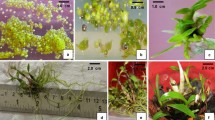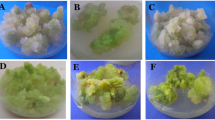Abstract
Almond shoots produced by axillary branching from clone VII derived from a seedling of cultivar Boa Casta were evaluated for somaclonal variation using randomly amplified polymorphic DNA (RAPD) and inter-simple sequence repeats (ISSR) analysis. To verify genetic stability we compared RAPD and ISSR patterns of plantlets obtained after 4 and 6 years of in vitro multiplication. A total of 64 RAPD and 10 ISSR primers gave 326 distinct and reproducible band classes, monomorphic across all 22 plantlets analysed. Thus, a total of 7,172 bands were generated, exhibiting homogeneous RAPD and ISSR patterns for the plantlets tested. These results suggest that the culture conditions used for axillary branching proliferation are appropriate for clonal propagation of almond clone VII, as they do not seem to interfere with the integrity of the regenerated plantlets. These results allowed us to establish the use of axillary branching plantlets (mother-plants) as internal controls for the analysis of somaclonal variation of shoots regenerated from other in vitro culture processes performed with clone VII (adventitious regeneration, regeneration from meristem culture, virus sanitation programs and genetic engineering).


Similar content being viewed by others
References
Ainsley PJ, Hammerschlag FA, Bertozzi T, Collins GG, Sedgley M (2001) Regeneration of almond from immature seed cotyledons. Plant Cell Tissue Organ Cult 67:221–226
Angel F, Barney VE, Tohme J, Roca WM (1996) Stability of cassava plants at the DNA level after retrieval from 10 years of in vitro storage. Euphytica 90:307–313
Antonelli M (1992) Regeneration from almond cotyledons: induction of proembryonal masses. Acta Hortic 300:255–260
Carvalho LC, Goulão L, Oliveira C, Gonçalves JC, Amâncio S (2004) RAPD assessment for identification of clonal identity and genetic stability of in vitro propagated chestnut hybrids. Plant Cell Tissue Organ Cult 77:23–27
Channuntapipat C, Sedgley M, Collins G (2003) Changes in methylation and structure of DNA from almond tissues during in vitro culture and cryopreservation. J Am Soc Hortic Sci 128:890–897
Damiano C, Archilletti T, Caboni E, Lauri P, Falasca G, Mariotti D, Ferraiolo G (1995) Agrobacterium-mediated transformation of almond: in vitro rooting through localized infection of A. rhizogenes W.T. Acta Hortic 392:161–170
Doyle JJ, Doyle JL (1987) A rapid DNA isolation procedure for small quantities of fresh leaf tissue. Phytochem Bull 19:11–15
Gonçalves MH (1998) Diagnose de infecções virais, saneamento de cultivares Portuguesas de amendoeira e pesquisa de estratégias para introdução de resistência a vírus. MSc thesis, Faculty of Sciences, University of Lisbon, Portugal
Goto S, Thakur RC, Ishii K (1998) Determination of genetic stability in long-term micropropagated shoots of Pinus thunbergii Parl. using RAPD markers. Plant Cell Rep 18:193–197
Gould AR (1986) Factors controlling generation of variability in vitro. In: Vasil IK (ed) Cell culture and somatic cell genetics in plants. 3. Plant regeneration and genetic variability. Academic, Orlando, pp 549–567
Hammerschlag FA (2000) Resistant responses of peach somaclone 122-1 to Xanthomonas campestris pv. pruni and to Pseudomonas syringae pv. syringae. HortScience 35:141–143
Hammerschlag FA, Bauchan GR, Scorza R (1987) Factors influencing in vitro multiplication and rooting of peach cultivars. Plant Cell Tissue Organ Cult 8:235–242
Hartmann C, Henry Y, De Buyser J, Aubry C, Rode A (1989) Identification of new mitochondrial genome organizations in wheat plants regenerated from somatic tissue cultures. Theor Appl Genet 77:169–175
Hashmi G, Huettel R, Meyer R, Krusberg L, Hammerschlag F (1997) RAPD analysis of somaclonal variants derived from embryo callus cultures of peach. Plant Cell Rep 16:624–627
Isabel N, Tremblay L, Michaud M, Tremblay FM, Bousquet J (1993) RAPDs as an aid to evaluate the genetic integrity of somatic embryogenesis-derived populations of Picea mariana (Mill.) B.S.P. Theor Appl Genet 86:81–87
Larkin P, Scowcroft WR (1981) Somaclonal variation, a novel source of variability from cell cultures for plant improvement. Theor Appl Genet 60:197–214
Lauri P, Caboni E, Damiano C (2001) In vitro adventitious shoot regeneration from vegetative apices of almond and other Prunus species. Acta Hortic 560:403–406
Martins M (2003) Análise molecular em amendoeira: da diversidade e estabilidade genómicas à identificação de resistências. PhD thesis, Faculty of Sciences, University of Lisbon, Portugal
Martins M, Tenreiro R, Oliveira MM (2003) Genetic relatedness of Portuguese almond cultivars assessed by RAPD and ISSR markers. Plant Cell Rep 22:71–78
Miguel CM (1998) Adventitious regeneration and genetic transformation of almond (Prunus dulcis Mill.). PhD thesis, Faculty of Sciences, University of Lisbon, Portugal
Miguel CM, Oliveira MM (1999) Transgenic almond (Prunus dulcis Mill.) plants obtained by Agrobacterium-mediated transformation of leaf explants. Plant Cell Rep 18:387–393
Miguel CM, Druart P, Oliveira M (1996) Shoot regeneration from adventitious buds induced on juvenile and adult almond (Prunus dulcis Mill.) explants. In Vitro Cell Dev Biol Plant 32:148–153
Murashige T, Skoog F (1962) A revised medium for rapid growth and bioassays with tobacco tissue cultures. Physiol Plant 15:473–497
Orton TJ (1985) Genetic instability during embryogenic cloning of celery. Plant Cell Tissue Organ Cult 4:159–169
Palombi MA, Damiano C (2002) Comparison between RAPD and SSR molecular markers in detecting genetic variation in kiwifruit (Actinidia deliciosa A. Chev). Plant Cell Rep 20:1061–1066
Rahman MH, Rajora OP (2001) Microsatellite DNA somaclonal variation in micropropagated trembling aspen (Populus tremuloides). Plant Cell Rep 20:531–536
Rani V, Parida A, Raina SN (1995) Random amplified polymorphic DNA (RAPD) markers for genetic analysis in micropropagated plants of Populus deltoides marsh. Plant Cell Rep 14:459–462
Rugini E, Verma DC (1983) Micropropagation of difficult-to-propagate almond (Prunus amygdalus Batsch.) cultivar. Plant Sci Lett 28:273–281
Shenoy VB, Vasil IK (1992) Biochemical and molecular analysis of plants derived from embryogenic tissue cultures of napiergrass (Pannisetum purpureum K. Schum). Theor Appl Genet 83:947–955
Tang W (2001) In vitro regeneration of loblolly pine and random amplified polymorphic DNA analyses of regenerated plantlets. Plant Cell Rep 20:163–168
Vendrame WA, Kochert G, Wetzstein HY (1999) AFLP analysis of variation in pecan somatic embryos. Plant Cell Rep 18:853–857
Weising K, Nybom H, Wolff K, Meyer W (1995) DNA fingerprinting in plants and fungi. CRC, Boca Raton
Williams JGK, Kubelik AR, Livak KJ, Rafalski JA, Tingey SV (1990) DNA polymorphisms amplified by arbitrary primers are useful as genetic markers. Nucleic Acids Res 18:6531–6535
Zietkiewicz E, Rafalski A, Labuda D (1994) Genome fingerprinting by simple sequence repeats (SSR)-anchored polymerase chain reaction amplification. Genomics 20:176–183
Acknowledgements
Part of this research was supported by Praxis XXI through the PhD grant BD/11323/97 provided to M.C. Martins and the research projects PRAXIS 3/3.2/HORT/2143/95. We also gratefully acknowledge Dr. Célia Miguel and Milene Costa, for providing the in vitro plant material.
Author information
Authors and Affiliations
Corresponding author
Additional information
Communicated by P. Puigdoménech
M. Martins and D. Sarmento contributed equally to this paper
Rights and permissions
About this article
Cite this article
Martins, M., Sarmento, D. & Oliveira, M.M. Genetic stability of micropropagated almond plantlets, as assessed by RAPD and ISSR markers. Plant Cell Rep 23, 492–496 (2004). https://doi.org/10.1007/s00299-004-0870-3
Received:
Revised:
Accepted:
Published:
Issue Date:
DOI: https://doi.org/10.1007/s00299-004-0870-3




